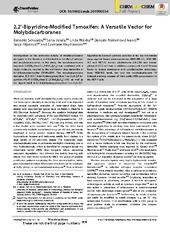Приказ основних података о документу
2,2'-Bipyridine-Modified Tamoxifen: A Versatile Vector for Molybdacarboranes.
| dc.creator | Schwarze, Benedikt | |
| dc.creator | Jelača, Sanja | |
| dc.creator | Welcke, Linda | |
| dc.creator | Maksimović-Ivanić, Danijela | |
| dc.creator | Mijatović, Sanja | |
| dc.creator | Hey-Hawkins, Evamarie | |
| dc.date.accessioned | 2019-12-05T14:23:09Z | |
| dc.date.available | 2019-12-05T14:23:09Z | |
| dc.date.issued | 2019 | |
| dc.identifier.issn | 1860-7179 | |
| dc.identifier.uri | https://onlinelibrary.wiley.com/doi/abs/10.1002/cmdc.201900554 | |
| dc.identifier.uri | https://radar.ibiss.bg.ac.rs/handle/123456789/3531 | |
| dc.description.abstract | Investigations on the antitumor activity of metallacarboranes are sparse in the literature and limited to a handful of ruthena- and molybdacarboranes. In this study, the molybdacarborane fragment [3-(CO)2 -closo-3,1,2-MoC2 B9 H11 ] was combined with a vector molecule, inspired by the well-known drug tamoxifen or 4,4'-dihydroxytamoxifen (TAM-diOH). The molybdacarborane derivative [3,3-{4-[1,1-bis(4-hydroxyphenyl)but-1-en-2-yl]-2,2'-bipyridine-κ2 N,N'}-3-(CO)2 -closo-3,1,2-MoC2 B9 H11 ] (10), as well as the ligand itself 4-[1,1-bis(4-hydroxyphenyl)but-1-en-2-yl]-2,2'-bipyridine (6) showed cytotoxic activities in the low micromolar range against breast adenocarcinoma (MDA-MB-231, MDA-MB-361 and MCF-7), human glioblastoma (LN-229) and human glioma (U-251) cell lines. In addition, compounds 6 and 10 were found to induce senescence and cytodestructive autophagy, lower ROS/RNS levels, but only the molybdacarborane 10 induced a strong increase of nitric oxide (NO) concentration in the MCF-7 cells. | en |
| dc.relation | info:eu-repo/grantAgreement/MESTD/Basic Research (BR or ON)/173013/RS// | |
| dc.relation | Fonds der Chemischen Industrie | |
| dc.relation | School Leipzig School of Natural Sciences – Building with Molecules and Nanoobjects | |
| dc.rights | openAccess | |
| dc.rights.uri | https://creativecommons.org/licenses/by/4.0/ | |
| dc.source | ChemMedChem | |
| dc.subject | breast cancer | |
| dc.subject | molybdacarborane | |
| dc.subject | nanoparticles | |
| dc.subject | nitric oxide (NO) | |
| dc.subject | tamoxifen | |
| dc.title | 2,2'-Bipyridine-Modified Tamoxifen: A Versatile Vector for Molybdacarboranes. | en |
| dc.type | article | en |
| dc.rights.license | BY | |
| dcterms.abstract | Хеy-Хаwкинс, Евамарие; Сцхwарзе, Бенедикт; Максимовић-Иванић, Данијела; Јелача, Сања; Wелцке, Линда; Мијатовић, Сања; | |
| dc.rights.holder | © 2019 The Authors. Published by Wiley-VCH Verlag GmbH & Co. KGaA. | |
| dc.citation.issue | 24 | |
| dc.citation.volume | 14 | |
| dc.identifier.doi | 10.1002/cmdc.201900554 | |
| dc.identifier.pmid | 31677361 | |
| dc.identifier.scopus | 2-s2.0-85075365747 | |
| dc.identifier.wos | 000496886800001 | |
| dc.citation.apa | Schwarze, B., Jelača, S., Welcke, L., Maksimović-Ivanić, D., Mijatović, S., & Hey-Hawkins, E. (2019). 2,2’-Bipyridine-Modified Tamoxifen: A Versatile Vector for Molybdacarboranes. ChemMedChem, cmdc.201900554. | |
| dc.citation.vancouver | Schwarze B, Jelača S, Welcke L, Maksimović-Ivanić D, Mijatović S, Hey-Hawkins E. 2,2’-Bipyridine-Modified Tamoxifen: A Versatile Vector for Molybdacarboranes. ChemMedChem. 2019;cmdc.201900554. | |
| dc.citation.spage | 2075 | |
| dc.citation.epage | 2083 | |
| dc.type.version | acceptedVersion | |
| dc.identifier.fulltext | https://radar.ibiss.bg.ac.rs/bitstream/id/5753/ChemMedChem_2019.pdf | |
| dc.citation.rank | M22 |

